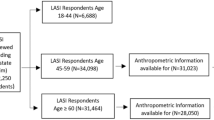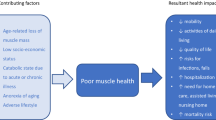Abstract
Background: Older people are becoming an increasingly important proportion of the populations of developing countries, yet little information exists on their nutritional status or social conditions.
Objective: To assess the nutritional status of older people in rural Malawi.
Design: Cross-sectional study.
Setting: Lilongwe, Malawi.
Subjects: A total of 296 respondents (97 males and 199 females) aged from 55–94 y were studied.
Methods: Selected anthropometric measurements were taken by trained personnel. Among kyphotic respondents, height was estimated from armspan using regression equations derived from the non-kyphotic respondents. Body mass index (BMI) and corrected arm muscle area (CAMA) were computed using standard equations.
Results: The mean age of the respondents was 63.3 y and 68.9 y among females and males, respectively. Kyphosis was seen in 17.3% of all subjects and oedema in 4.1%. Nearly 90% of the subjects were involved in agricultural activities. Men were heavier and taller than women but women had larger MUACs and triceps skinfolds than males. The mean BMIs in kg/m2 (±s.d.) were as follows: 19.7 (2.6) for men and 20.3 (3.0) for women. The prevalence of undernutrition, defined as BMI<18.5 kg/m2, was 36.1% among males and 27.0% among females. In contrast, using MUAC (cut-offs 23 cm for males and 22 cm for females), 20.4% of the men and only 10% of the women were classified as malnourished.
Conclusion: The study demonstrated for the first time that undernutrition is a significant problem among older people in rural Malawi. It highlights the need to incorporate older people into existing and future nutrition and health programmes.
Sponsorship: The study was funded through a scholarship from the Association of Commonwealth Universities, the Research and Publications Committee of the University of Malawi, and Norvatis Foundation for Gerontological Research, Switzerland.
This is a preview of subscription content, access via your institution
Access options
Subscribe to this journal
Receive 12 print issues and online access
$259.00 per year
only $21.58 per issue
Buy this article
- Purchase on Springer Link
- Instant access to full article PDF
Prices may be subject to local taxes which are calculated during checkout
Similar content being viewed by others
Author information
Authors and Affiliations
Rights and permissions
About this article
Cite this article
Chilima, D., Ismail, S. Anthropometric characteristics of older people in rural Malawi. Eur J Clin Nutr 52, 643–649 (1998). https://doi.org/10.1038/sj.ejcn.1600617
Received:
Revised:
Accepted:
Published:
Issue Date:
DOI: https://doi.org/10.1038/sj.ejcn.1600617
Keywords
This article is cited by
-
Prevalence and correlates of diabetes mellitus in Malawi: population-based national NCD STEPS survey
BMC Endocrine Disorders (2014)
-
The anthropometric status of elderly women in rural Ghana and factors associated with low body mass index
The Journal of nutrition, health and aging (2012)
-
Which Measure of Abdominal Adiposity Best Relates with Body Mass Index Among Older Bengalee Hindus of Kolkata, India? A Comparison of Three Measures
International Journal of Anthropology (2007)
-
Nutritional status following malaria control in a Vietnamese ethnic minority commune
European Journal of Clinical Nutrition (2005)
-
Socio-demographic, behavioral and functional characteristics of groups of community and institutionalized elderly Quechua Indians of Peru, and their association with nutritional status
Journal of Cross-Cultural Gerontology (2005)



